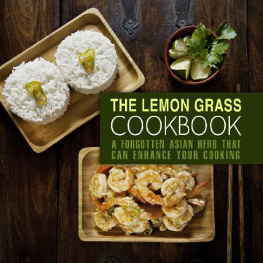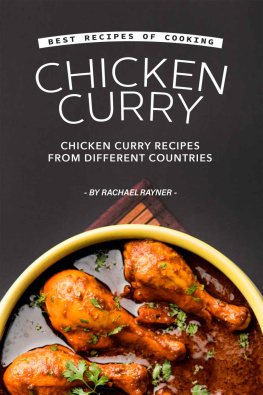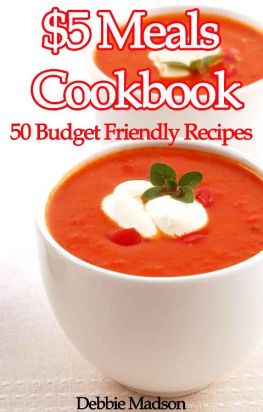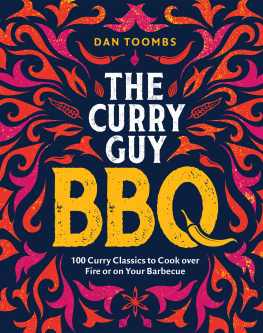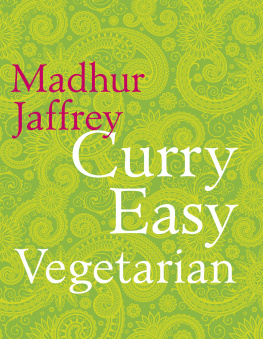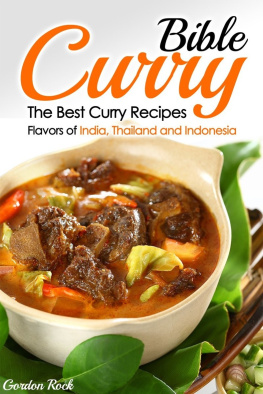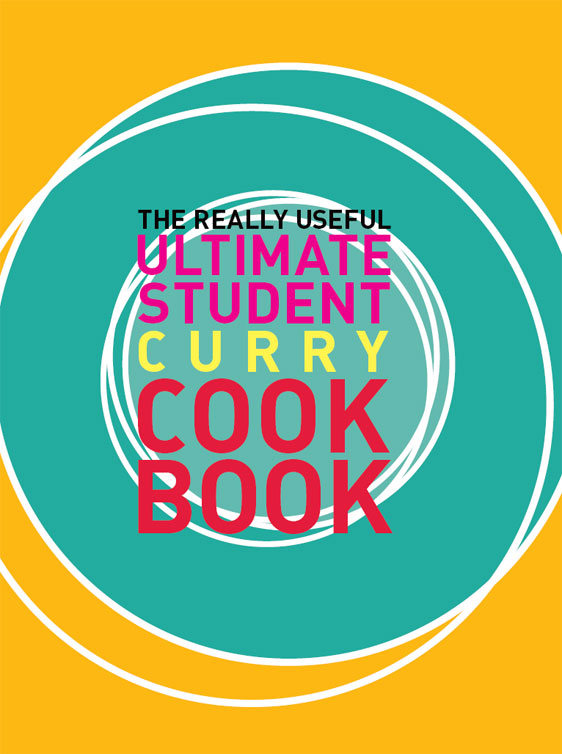Published by Murdoch Books Pty Limited Murdoch Books Australia
Pier 8/9, 23 Hickson Road, Millers Point NSW 2000
Phone: +61 (0) 2 8220 2000 Fax: +61 (0) 2 8220 2558 Murdoch Books UK Limited
Erico House, 6th Floor, 93-99 Upper Richmond Road
Putney, London SW15 2TG
Phone: +44 (0) 20 8785 5995 Fax: + 44 (0) 20 8785 5985 Chief Executive: Juliet Rogers
Publisher: Kay Scarlett Publisher: Lynn Lewis
Designers: Heather Menzies and Clare OLoughlin
Project Editor: Zoe Harpham
Editorial Coordinator: Liz Malcolm
Production: Joan Beal Title: The really useful ultimate student curry cookbook [electronic resource]. ISBN: 9781742665047 (ebook) Notes: Includes index. Subjects: Cooking (Curry)
Low budget cooking. Dewey Number: 641.6384 Text, design and photography Murdoch Books Pty Limited 2010. All rights reserved. No part of this publication may be reproduced, stored in a retrieval system or transmitted in any form or by any means, electronic, mechanical, photocopying, recording or otherwise without the prior written permission of the publisher.
IMPORTANT: Those who might be at risk from the effects of salmonella poisoning (the elderly, pregnant women, young children and those suffering from immune deficiency diseases) should consult their doctor with any concerns about eating raw eggs. CONVERSION GUIDE: You may find cooking times vary depending on the oven you are using. For fan-forced ovens, as a general rule, set the oven temperature to 20C (70F) lower than indicated in the recipe. We have used 20 ml (4 teaspoon) tablespoon measures. If you are using a 15 ml (3 teaspoon) tablespoon, for most recipes the difference will not be noticeable. However, for recipes using baking powder, gelatine, bicarbonate of soda, small amounts of flour and cornflour (cornstarch), add an extra teaspoon for each tablespoon specified.
Contents
INTRODUCTION
Traditionally, curry was eaten in India and South East Asia, but its popularity has grown in recent decades and it has become a vital part of international cuisine, enjoyed all over the world. Each country has its own interpretation of curried dishes built on local ingredients and culinary traditions. Not all curries are fiery hot with chillies a popular misconception. This book is filled with recipes ranging from hot and spicy Indian curries and sweet and creamy Thai curries, to milder vegetarian and seafood options something to suit every taste and mood. Its well known that curries are packed with flavour, but theyre also healthy and even better, simple to cook. If youre new to cooking, youll find yourself able to master the art of creating the perfect curry in very little time.
Its an ideal dish if youre a student because it can be left to cook for a few hours while you study, or prepared in advance and frozen, then reheated when you need a quick meal. Its also a great dish to share with a group of friends at the end of a long day. Serve it with some of the side dishes and accompaniments featured in this book, such as cucumber raita or naan bread, and its sure to be a winner. Before you begin cooking, its worthwhile stocking your cupboards with some of the essential ingredients and spices youll need. Theres an on to help you do just that. Pay a visit to your local Indian or Asian supermarket to investigate what they have on offer, and ask for advice on anything youre unsure of.
Keep in mind its best to buy little and often, because many pre-ground spices will lose their pungency well before their use-by date and fresh produce has a limited lifespan. If you can, buy spices whole and grind them yourself as needed. As well as plenty of curry recipes, this book has information on the different types of rice available, and how to cook and store them. It also has advice on eating well, with top tips for keeping your diet balanced, and important information on food safety and how to store, prepare, defrost and reheat your food correctly. Armed with all this knowledge, and some fantastic recipes, youll not only be on the path to creating delicious curries, but a healthy, balanced lifestyle that will help you keep on top of your studies. Happy cooking!
EATING WELL
Eating well is the key to getting the best from life.
If you plan to cram your revision or study late into the night, it is essential that you eat a well-balanced diet that will not only keep your mind and body fuelled, but can also help prevent heart disease, tooth decay and obesity as well as many other common illnesses. Studies have shown, for example, that youre less likely to get a cold if you have a good intake of vitamin C, which is something to think about if youve got exams or a heavy workload looming. Generally speaking, the more varied your diet, the more likely it is that all the vital nutrients you need are being provided. In order to ensure you are getting enough, you must be eating from each of the three main food groups detailed below. Having discovered how to plan good, balanced meals you should also take a look at the snacks you eat between meals. Try to drink plenty of water and eat yoghurts or fruit if you get hunger pangs sugary drinks and fried salty snacks will just help you to pile on the weight, and offer very little by way of nutrients.
GROUP 1 CARBOHYDRATES Starchy foods such as potatoes and bread are good sources of fibre, vitamins and minerals. Carbohydrates like these should be the base of every meal. They are naturally low in fat (and as a nation, we consume far more fat than we need), and will satisfy your hunger. Your body needs carbohydrates to convert into energy but there are two main types: starch and sugar. When you eat a sugar-filled food or drink, you get an almost instant energy surge, which is quickly followed by a low. Your brain tells you that you need more energy and you crave another bar of chocolate or can of fizzy pop.
Yo-yoing energy levels can leave you feeling lethargic and unable to concentrate on your studies. Because starches are digested by the body far more slowly than sugars, they give a constant slow-releasing source of energy which is exactly what you need if youre going into a three-hour exam. If you have a heavy day ahead, you must eat a proper breakfast. When you wake up, your sugar levels are low so boost them up with sustaining food. Have a couple of slices of toast and Marmite or a good quality-fruit preserve and a big bowl of muesli or porridge. Avoid tea or coffee and have a glass of fresh orange juice instead.
At meal times, go for filled baked potatoes, risottos, stews, curries and pair stir-fries, soups or salads with a carbohydrate for a healthy, well-balanced meal. Good carbohydrates include: rice and grains pulses: lentils, beans and dried peas breakfast cereals: muesli, porridge and wheat blocks, not sugar coated cereals bread: wholemeal is best but white is still good pasta potatoes noodles GROUP 2 PROTEIN The body needs protein for the production of body tissue, so to keep strong and healthy, it must be included in your diet. Most people easily consume enough protein so it is not something that you really need to worry about, but it is worth keeping an eye on if you are vegetarian, constantly dieting, or on a very limited budget for food. You dont need to consume a lot, but you should make an effort to include a small amount with each meal. Unfortunately, a lot of high protein food is also high in fat, so choose lean meat and trim off any fat, and be aware of how much cheese, cream and butter you eat. The type and quality of protein varies greatly in different foods.
Animal proteins such as fish, milk and poultry are the most complete, but there are plenty of good, but not quite as complex plant sources of protein to be found in carbohydrates such as grains, pulses, beans and potatoes. The best way to ensure quality, not just quantity, is to try and combine proteins so they complement each other. This is particularly important if youre vegetarian and even more so for vegans who dont eat dairy produce. Try and eat at least two different foods together to obtain a high quality protein; fortunately this is the way that most foods go together anyway a good example is baked beans on toast which is a very good high fibre, high protein, low-fat snack meal. Quality High Protein Foods Include: fish and shellfish lean meat poultry milk yoghurt cheese eggs butter tofu nuts seeds peanut butter seaweed grains beans cereals pasta GROUP 3 FRUIT & VEGETABLES The World Health Organisation recommends that we eat at least 400g, thats almost a pound, or five portions of fruit and vegetables a day that doesnt include potatoes but does include beans, nuts and seeds. Fruit and vegetables are packed with different vitamins and minerals, so you should try and vary the types you eat and remember that its impossible to eat too much.






